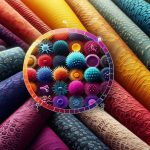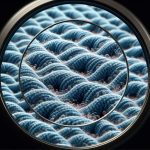Imagine you're wearing a shirt that not only looks good but also actively kills bacteria, reducing odor and keeping you fresh longer. This is the promise of antimicrobial fabrics, where agents like silver ions and copper disrupt microorganism cell walls, leading to their inactivation. These fabrics aren't just about hygiene; they extend the lifespan of your clothes and reduce textile waste. So, how exactly do these materials work, and what benefits do they offer in various industries?
Table of Contents
Key Takeaways
- Antimicrobial fabrics incorporate agents like silver ions and copper to disrupt microbial cell walls.
- These fabrics prevent infections, reduce odors, and enhance hygiene by inhibiting bacterial growth.
- High-quality antimicrobial fabrics maintain effectiveness through multiple wash cycles and extended use.
- Silver nanoparticles and copper ions are common agents, offering broad-spectrum antimicrobial activity.
- Antimicrobial textiles are used in fashion, medical, sports, and home furnishing industries for durability and hygiene.
How Antimicrobial Fabrics Work
Antimicrobial fabrics work by incorporating agents that disrupt the growth and reproduction of microorganisms. To understand the mechanism, you must first recognize that these fabrics embed antimicrobial agents like silver ions, triclosan, or copper. These agents interact with the cell walls of bacteria, fungi, and viruses, compromising their structural integrity. The disruption of cell walls leads to leakage of cellular contents, ultimately causing the microorganisms to die or become ineffective.
Next, let's talk about the effectiveness of these fabrics. It's not just about killing microorganisms; it's about how well these agents maintain their antimicrobial properties over time. When you wash antimicrobial fabrics, the agents should ideally remain active and not wash out. High-quality antimicrobial fabrics will retain their effectiveness through multiple wash cycles and extended use. This is critical for applications in healthcare, sportswear, and everyday clothing where hygiene is paramount.
Understanding the mechanism and guaranteeing the effectiveness of antimicrobial agents in fabrics are key. You must pay attention to the type of antimicrobial agent used and its durability. This safeguards that you're getting a product that offers sustained protection against harmful microorganisms.
Benefits of Antimicrobial Fabrics
In addition to their ability to combat harmful microorganisms, fabrics with antimicrobial properties offer numerous benefits that enhance both hygiene and comfort. You'll find that these fabrics not only protect you from potential health risks but also enhance your daily life.
Health benefits and durability: By reducing the presence of harmful bacteria, antimicrobial fabrics help prevent infections and skin irritations. Their enhanced durability means they maintain their protective properties even after multiple washes, ensuring long-term health benefits.
Odor control: These fabrics effectively neutralize odors by inhibiting the growth of odor-causing bacteria. Whether you're wearing activewear or using antimicrobial bed linens, you'll experience a fresher, more pleasant environment, boosting your confidence and well-being.
Sustainability: Antimicrobial fabrics contribute to sustainability by reducing the need for frequent washing, thereby conserving water and energy. Additionally, their extended lifespan means fewer replacements, resulting in less textile waste.
Integrating antimicrobial fabrics into your lifestyle is a smart choice for those who value cleanliness, durability, and environmental responsibility. These benefits collectively enhance your quality of life, making antimicrobial fabrics an indispensable part of your daily routine.
Common Antimicrobial Agents
When exploring fabrics with antimicrobial properties, you'll encounter a variety of agents that effectively combat harmful microorganisms. Among the most prominent are silver nanoparticles and copper ions. These agents are renowned for their potent antimicrobial effects and their ability to enhance fabric performance.
Silver nanoparticles are incredibly effective due to their high surface area-to-volume ratio, which allows them to interact with microbial cells efficiently. They disrupt cell membranes and interfere with crucial cellular processes, leading to the death of the microorganisms. On the other hand, copper ions function by generating oxidative stress within microbial cells, damaging their DNA and proteins, which ultimately leads to their demise.
Here's a quick comparison of these two agents:
| Antimicrobial Agent | Mechanism of Action |
|---|---|
| Silver Nanoparticles | Disrupt cell membranes, interfere with cellular functions |
| Copper Ions | Generate oxidative stress, damage DNA and proteins |
| Antimicrobial Agent | Advantages |
| Silver Nanoparticles | High efficiency, broad-spectrum activity |
| Copper Ions | Strong antimicrobial properties, cost-effective |
Applications in Various Industries
Across various industries, fabrics with antimicrobial properties play a pivotal role in enhancing hygiene and safety standards. Imagine the impact on the fashion industry where clothing not only looks good but also stays fresh longer, reducing the frequency of washes and extending garment life. You're not just dressing stylishly; you're embracing a smarter, more sustainable way to wear clothes.
In the medical field, antimicrobial fabrics are nothing short of essential. Think of uniforms, bed linens, and surgical drapes that actively combat bacteria and other pathogens, markedly lowering the risk of hospital-acquired infections. Your commitment to incorporating these materials ensures a safer environment for both patients and healthcare workers.
Consider sports gear too. High-performance athletes rely on gear that stays odor-free and hygienic, even during the most intense workouts. Antimicrobial technology keeps their equipment in top shape, enhancing performance and comfort.
And let's not forget home furnishings. From antimicrobial curtains to bed linens, these fabrics create a healthier living space for you and your family.
Here's why you should care:
- Enhanced hygiene – Live in a cleaner, safer environment.
- Increased durability – Extend the life of your fabrics.
- Superior comfort – Experience fresher, more comfortable textiles.
Future of Antimicrobial Textiles
Looking ahead, you can expect antimicrobial textiles to revolutionize hygiene and sustainability in everyday life. The integration of these fabrics into clothing, medical supplies, and home goods will greatly reduce the spread of pathogens. As you focus on sustainability concerns, you'll appreciate how these textiles can extend the lifespan of products by minimizing bacterial degradation and odor.
Technological advancements are set to play a pivotal role in this transformation. Innovations in nanotechnology and bioengineering are enabling the development of more effective antimicrobial agents embedded within the fabric fibers. You'll find these advancements not only enhance the protective qualities but also guarantee that the antimicrobial properties remain intact even after multiple washes.
Moreover, the future of antimicrobial textiles will likely see a fusion of functionality and eco-friendliness. Researchers are working on creating biodegradable antimicrobial agents, which address both hygiene and environmental impact. This dual focus guarantees that as you adopt these advanced textiles, you're also contributing to a more sustainable planet.
In essence, the future of antimicrobial textiles promises a perfect blend of superior hygiene and sustainability, driven by cutting-edge technological advancements. Embrace this future, and you'll be at the forefront of a cleaner, greener world.
Frequently Asked Questions
Are Antimicrobial Fabrics Safe for Sensitive Skin?
You won't believe how safe these fabrics are! They're designed to minimize skin irritation and maximize compatibility. Even with your sensitivity, the chance of reactions is practically nonexistent, ensuring your comfort and peace of mind.
How Should Antimicrobial Fabrics Be Washed and Maintained?
For proper care and fabric maintenance, follow specific washing instructions to guarantee longevity. Use mild detergent, cold water, and avoid fabric softeners or bleach. Air-dry or tumble dry on low heat to protect antimicrobial properties.
Do Antimicrobial Properties Affect the Fabric's Breathability?
Investigate the truth: Do antimicrobial properties affect breathability? They don't greatly impact it. You'll still enjoy moisture-wicking, odor control, and comfort levels. Plus, fabric durability remains intact. So, breathe easy and master your comfort!
Can Antimicrobial Fabrics Cause Allergic Reactions?
You're wondering if antimicrobial fabrics can cause allergic reactions. While most are safe, some people with skin sensitivity might react to antimicrobial textiles. Always test a small area first to guarantee your skin's comfort.
What Certifications Should Consumers Look for in Antimicrobial Fabrics?
Did you know that over 90% of consumers trust certified products more? Look for certification standards like OEKO-TEX or EPA to confirm antimicrobial effectiveness. They assure the fabric's safety and performance, giving you peace of mind.
- What Does Fabric Chino Mean? Exploring Chino Fabric - June 20, 2025
- What Are the Requirements to Ship Fabric to China? A Complete Guide - June 20, 2025
- Should You Use Fabric Softener on Chinos? Care Tips - June 20, 2025







